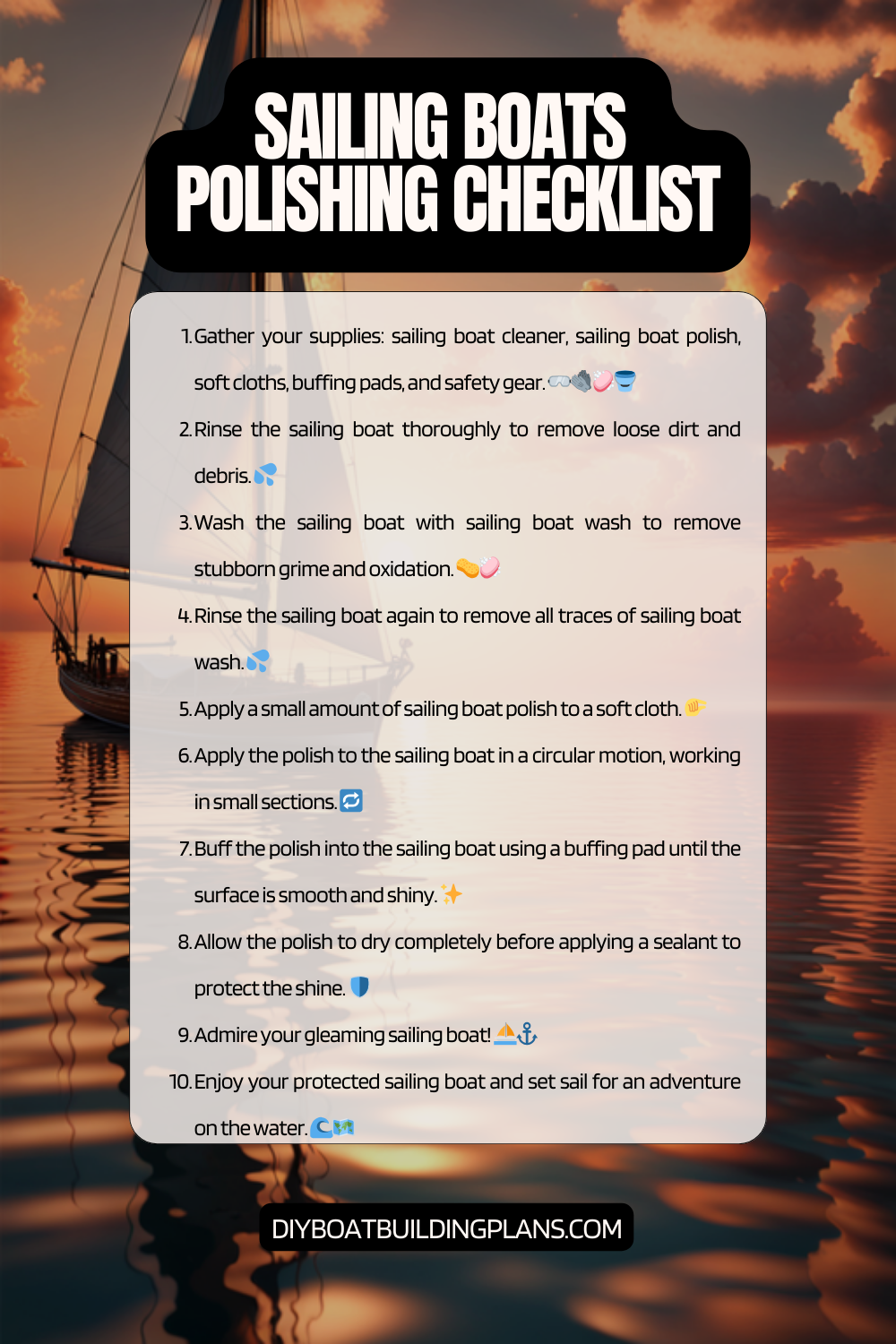Overview of Sailing Boat Polishing Tips
Sailing boat polishing is the process of restoring and maintaining the shine and luster of a boat’s exterior surfaces. It involves the use of specialized products and techniques to remove oxidation, stains, and scratches, and to protect the boat from further damage. Boat polishing is not only important for aesthetic reasons but also for the overall health and longevity of the vessel.
Key Takeaways
- Regular boat polishing is important to maintain the appearance and value of your sailing boat.
- Choosing the right polishing products and preparing the boat properly are crucial for achieving a polished surface.
- Different polishing techniques should be used for different boat surfaces, and stubborn stains and oxidation can be removed with the right methods.
- Safety should always be a top priority when polishing a sailing boat, and maintaining the polished surface is key to prolonging its lifespan.
- While professional polishing services can be convenient, DIY polishing can save money and allow for more frequent polishing.

Importance of Regular Boat Polishing
Regular boat polishing offers a multitude of benefits. Firstly, it enhances the appearance of the boat, making it look clean, shiny, and well-maintained. This is particularly important for sailing boat owners who take pride in their vessel’s appearance or those who use their boats for commercial purposes, such as chartering or events.
Moreover, regular boat polishing helps to protect the boat’s surfaces from the harsh effects of the sun, saltwater, and other environmental factors. The polishing process creates a protective barrier that shields the boat from UV rays, preventing fading and discoloration. It also helps to repel dirt, grime, and salt deposits, making it easier to clean the boat in the future.
On the other hand, neglecting boat polishing can have serious consequences. Over time, oxidation can occur on the boat’s surfaces, resulting in a dull and faded appearance. This not only diminishes the aesthetic appeal but also weakens the structural integrity of the boat. Additionally, neglecting regular polishing can lead to the buildup of stubborn stains and scratches that are difficult to remove without professional intervention.
Choosing the Right Polishing Products
When it comes to choosing the right polishing products for your sailing boat, there are several factors to consider. Firstly, you need to determine the type of surface you will be working on. Different surfaces require different types of products. For example, fiberglass boats require specific fiberglass polish, while gelcoat surfaces may require a different type of polish.
Another important factor to consider is the condition of your boat’s surfaces. If your boat has heavy oxidation or deep scratches, you may need more aggressive polishing compounds to effectively restore the surface. However, if your boat is in relatively good condition, a milder polish may be sufficient for regular maintenance.
It is also crucial to consider the environmental impact of the products you choose. Look for eco-friendly options that are biodegradable and do not contain harmful chemicals that can harm marine life. Additionally, consider the ease of use and application of the products, as well as their durability and longevity.
Preparing the Boat for Polishing
| Task | Time Required | Materials Needed | Tools Required |
|---|---|---|---|
| Cleaning the Boat | 2 hours | Boat soap, water, scrub brush, sponge | Bucket, hose |
| Sanding the Boat | 4 hours | Sandpaper (various grits), sanding block, masking tape | Orbital sander, dust mask, safety glasses |
| Applying Compound | 3 hours | Compound, applicator pad, microfiber towel | Buffer, extension cord |
| Polishing the Boat | 2 hours | Polish, applicator pad, microfiber towel | Buffer, extension cord |
Before you begin the polishing process, it is essential to thoroughly clean the boat’s surfaces. Use a mild detergent or boat soap to remove any dirt, grime, or salt deposits. Rinse the boat thoroughly with fresh water and allow it to dry completely before proceeding with the polishing.
If there is old wax or polish on the boat’s surfaces, it is important to remove it before applying new polish. This can be done using a wax remover or a specialized stripping compound. Follow the manufacturer’s instructions carefully and ensure that all traces of old wax or polish are completely removed.
Polishing Techniques for Different Boat Surfaces
Different boat surfaces require different polishing techniques to achieve the best results. For fiberglass surfaces, start by applying a small amount of fiberglass polish onto a clean microfiber cloth or applicator pad. Work in small sections, applying the polish in circular motions. Once the polish has been evenly applied, use a clean microfiber cloth to buff away any excess and reveal a smooth and shiny surface.
Gelcoat surfaces can be polished using similar techniques as fiberglass, but it is important to choose a gelcoat-specific polish for optimal results. Metal surfaces, such as stainless steel or aluminum, require specialized metal polishes that are designed to remove oxidation and restore shine. Apply the metal polish using a clean cloth or applicator pad, following the manufacturer’s instructions, and buff away any residue to achieve a polished finish.
To achieve a smooth and even finish, it is important to work in small sections and avoid applying too much pressure. Allow the polish to dry before buffing away any excess residue. It is also recommended to use a dual-action polisher or buffer for larger surfaces, as this can help to achieve a more consistent and efficient result.
How to Remove Stubborn Stains and Oxidation
Stubborn stains and oxidation can be a common problem on sailing boats, particularly those that are exposed to harsh environmental conditions. To effectively remove these blemishes, it is important to understand their causes and employ the right techniques.
Stubborn stains can be caused by various factors, such as bird droppings, rust, or waterline marks. To remove these stains, start by applying a stain remover or specialized cleaner onto the affected area. Allow the cleaner to penetrate the stain for a few minutes before gently scrubbing with a soft brush or sponge. Rinse the area thoroughly with fresh water and repeat the process if necessary.
Oxidation occurs when the boat’s surfaces are exposed to UV rays and other environmental factors over time. This results in a dull and faded appearance. To remove oxidation, use a cutting compound or oxidation remover specifically designed for boat surfaces. Apply the compound using a clean cloth or applicator pad, working in small sections. Use circular motions and apply light to moderate pressure until the oxidation is removed. Follow up with a finer polish to restore shine and protect the surface.
Polishing Safety Tips
When polishing a sailing boat, it is important to prioritize safety. Here are some safety tips to keep in mind:
1. Wear protective gear such as gloves, safety glasses, and a dust mask to protect yourself from chemicals and debris.
2. Work in a well-ventilated area to avoid inhaling fumes.
3. Avoid working in direct sunlight, as this can cause the polish to dry too quickly and result in uneven application.
4. Use caution when working on elevated surfaces or near water to prevent accidents or falls.
5. Follow the manufacturer’s instructions for each product and avoid mixing different chemicals or products.
Maintaining the Polished Surface
Once you have achieved a polished surface on your sailing boat, it is important to maintain it to prolong its lifespan and appearance. Here are some tips for maintaining the polished surface:
1. Regularly wash the boat with a mild detergent or boat soap to remove dirt, grime, and salt deposits.
2. Apply a protective wax or sealant after each polishing session to provide an additional layer of protection against UV rays and environmental factors.
3. Avoid using abrasive cleaners or brushes that can scratch the surface.
4. Rinse the boat thoroughly with fresh water after each use to remove saltwater and prevent corrosion.
5. Inspect the boat regularly for any signs of damage or wear and address them promptly to prevent further deterioration.
Polishing Frequency and Schedule
The frequency of boat polishing depends on various factors, such as the boat’s usage, environmental conditions, and the condition of the surfaces. As a general guideline, it is recommended to polish a sailing boat at least once a year for regular maintenance. However, boats that are used frequently or exposed to harsh conditions may require more frequent polishing.
Factors such as sun exposure, saltwater exposure, and storage conditions can also affect the polishing schedule. If you notice signs of oxidation, fading, or stains, it may be necessary to polish the boat more often to restore and maintain its appearance.
Download over 500 Boat Plans. Click on the link below.
-->Click Here<--
Professional Polishing Services vs DIY
When it comes to boat polishing, you have the option of hiring a professional polishing service or doing it yourself. Both options have their pros and cons.
Hiring a professional polishing service can save you time and effort, especially if you have a large boat or lack the necessary equipment and expertise. Professionals have access to specialized tools and products, and they are experienced in achieving optimal results. However, professional services can be costly, and you may need to schedule appointments in advance.
On the other hand, DIY boat polishing allows you to have more control over the process and can be more cost-effective in the long run. With the right products and techniques, you can achieve professional-looking results. However, it requires time, effort, and attention to detail. DIY polishing also allows you to develop a deeper understanding of your boat’s surfaces and maintenance needs.
Sailing Boat Polishing Checklist

Conclusion – Sailing Boat Polishing Tips
In conclusion, sailing boat polishing is an essential part of boat maintenance that offers numerous benefits. Regular polishing not only enhances the appearance of the boat but also protects it from environmental damage. Choosing the right polishing products and techniques is crucial for achieving optimal results.
Proper preparation, including thorough cleaning and removal of old wax or polish, is essential before starting the polishing process. Different surfaces require different techniques, so it is important to understand the specific requirements for fiberglass, gelcoat, and metal surfaces.
Removing stubborn stains and oxidation requires specialized cleaners and compounds. Safety should always be a priority when polishing a boat, so wearing protective gear and following safety precautions is crucial.
Maintaining the polished surface involves regular washing, applying protective wax or sealant, and addressing any signs of damage promptly. The frequency of boat polishing depends on various factors, including usage and environmental conditions.
Lastly, choosing between professional polishing services and DIY depends on personal preferences, budget, and available resources. Both options have their advantages and disadvantages.
By following these tips and guidelines, you can achieve a polished sailing boat that not only looks great but also stands the test of time.
FAQs – Sailing Boat Polishing Tips
What is boat polishing?
Boat polishing is the process of removing oxidation, stains, and scratches from the surface of a boat to restore its shine and protect it from further damage.
Why is boat polishing important?
Boat polishing is important because it helps to maintain the appearance and value of a boat. It also helps to protect the boat from the damaging effects of the sun, saltwater, and other environmental factors.
What are some tips for polishing a sailing boat?
Some tips for polishing a sailing boat include using a high-quality polishing compound, working in small sections, using a polishing machine or buffer, and applying a protective wax or sealant after polishing.
What types of polishing compounds are available for sailing boats?
There are several types of polishing compounds available for sailing boats, including rubbing compounds, polishing compounds, and finishing compounds. Rubbing compounds are the most abrasive and are used to remove heavy oxidation and scratches. Polishing compounds are less abrasive and are used to remove light oxidation and stains. Finishing compounds are the least abrasive and are used to create a high-gloss finish.
What is the best way to apply a polishing compound?
The best way to apply a polishing compound is to work in small sections, using a polishing machine or buffer. Apply a small amount of compound to the surface of the boat and work it in using circular motions. Use light pressure and work in small sections until the entire boat has been polished.
How often should a sailing boat be polished?
The frequency of boat polishing depends on several factors, including the age of the boat, the condition of the gelcoat, and the amount of use the boat gets. As a general rule, it is recommended to polish a sailing boat at least once a year to maintain its appearance and protect it from damage.



